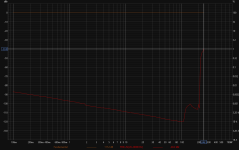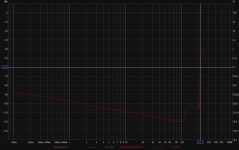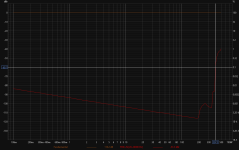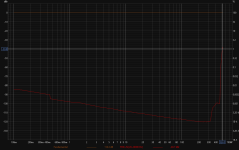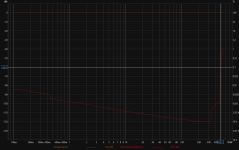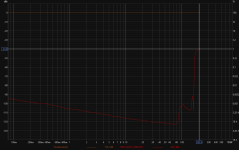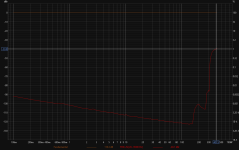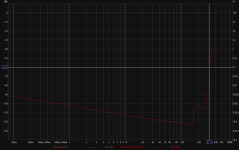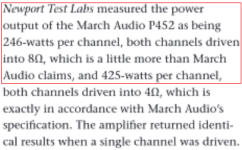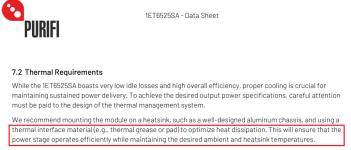Hi everyone
Exciting times at March Towers. The new Purifi 1ET6525 modules have finally arrived. A special thanks to Fedex for losing them for 4 weeks!!!
Anyway, we have been busy testing them in our new P482 amplifier. This replaces the P422 in a few weeks. The new amp has a revised power supply and features our "ultra buffer" that was developed for our flagship P801 monoblocks. The new buffer is required to take advantage of the improved performance these latest generation Purifi modules.
We are confident our engineering skills have made this is the lowest noise, lowest distortion and highest power output implementation of the Purifi 1Et6525 modules.

Headline specs (actual measured performance *NOT* Purifi module datasheet numbers):
Measurements taken with 21.0dB gain setting and BOTH channels driven.
Power:
246 Watts 8 ohm 1% THD
490 Watts 4 ohm 1% THD
540 Watts 2 ohm 1% THD
Output Noise:
7.6uV RMS (20Hz to 20kHz, input shorted)
DC Offset = 0.3074mV
THD:
-133dB (20Hz to 20kHz)
THD+N (SINAD)
-115dB @ 4.475V RMS, 4 ohm load, 5 watts
Gain Options (selectable on rear panel switch)
21.0dB (full power output with 4.0V RMS standard domestic XLR input/source)
27.0dB (full power output with 2.0V RMS standard RCA input/source)
Be wary of other manufacturers "gaming"" the SINAD figures with unusably low gain settings.
As you possibly know, we are very close to the measurement limits where it becomes difficult to discern between the noise and distortion of the measurement system and that of the device under test. Below is some of the data.
As discussed previously regarding our P801 amplifier, due to their very low noise it is very difficult to accurately measure the SINAD. The gain of the input buffer and power amp module amplifies the inherent noise of the signal generator/DAC. Most amplifiers noise masks and swamps the noise of the signal source, but with these amplifiers it needs to be taken into account.
Below I have shown the amplifiers inherent noise, measured with the input shorted. I have also shown the amp output noise with the signal source/generator connected:
Input shorted = -115.45dB
With signal generator connected = -112.45dB
Due to this the measured THD+N is lower than it should be due to the signal generator noise. Hence to calculate the actual THD+N / SINAD we need to add the measured THD and the amp noise measured with the input shorted:
(-134.3dB) + (115.34dB) = -115.3dB
As you can see, the final SINAD is dictated by the noise and not the THD.
Graphs
Output Noise with input shorted
7.6uV

Noise, Input shorted dBFS.
FS = 4.6565V rms = FS = -115.8dB
REF 4.475V RMS (5 watts 4 ohms) = -115.45dB

Noise with signal generator connected
REF 4.475V RMS = -112.45dB

THD / THD+N
REF 4.475V RMS (5 watts 4 ohms) = -111.9dB
CORRECTED = -115.3dB

Power curves to follow.
Needless to say, it sounds incredible !
!
Exciting times at March Towers. The new Purifi 1ET6525 modules have finally arrived. A special thanks to Fedex for losing them for 4 weeks!!!
Anyway, we have been busy testing them in our new P482 amplifier. This replaces the P422 in a few weeks. The new amp has a revised power supply and features our "ultra buffer" that was developed for our flagship P801 monoblocks. The new buffer is required to take advantage of the improved performance these latest generation Purifi modules.
We are confident our engineering skills have made this is the lowest noise, lowest distortion and highest power output implementation of the Purifi 1Et6525 modules.
Headline specs (actual measured performance *NOT* Purifi module datasheet numbers):
Measurements taken with 21.0dB gain setting and BOTH channels driven.
Power:
246 Watts 8 ohm 1% THD
490 Watts 4 ohm 1% THD
540 Watts 2 ohm 1% THD
Output Noise:
7.6uV RMS (20Hz to 20kHz, input shorted)
DC Offset = 0.3074mV
THD:
-133dB (20Hz to 20kHz)
THD+N (SINAD)
-115dB @ 4.475V RMS, 4 ohm load, 5 watts
Gain Options (selectable on rear panel switch)
21.0dB (full power output with 4.0V RMS standard domestic XLR input/source)
27.0dB (full power output with 2.0V RMS standard RCA input/source)
Be wary of other manufacturers "gaming"" the SINAD figures with unusably low gain settings.
As you possibly know, we are very close to the measurement limits where it becomes difficult to discern between the noise and distortion of the measurement system and that of the device under test. Below is some of the data.
As discussed previously regarding our P801 amplifier, due to their very low noise it is very difficult to accurately measure the SINAD. The gain of the input buffer and power amp module amplifies the inherent noise of the signal generator/DAC. Most amplifiers noise masks and swamps the noise of the signal source, but with these amplifiers it needs to be taken into account.
Below I have shown the amplifiers inherent noise, measured with the input shorted. I have also shown the amp output noise with the signal source/generator connected:
Input shorted = -115.45dB
With signal generator connected = -112.45dB
Due to this the measured THD+N is lower than it should be due to the signal generator noise. Hence to calculate the actual THD+N / SINAD we need to add the measured THD and the amp noise measured with the input shorted:
(-134.3dB) + (115.34dB) = -115.3dB
As you can see, the final SINAD is dictated by the noise and not the THD.
Graphs
Output Noise with input shorted
7.6uV
Noise, Input shorted dBFS.
FS = 4.6565V rms = FS = -115.8dB
REF 4.475V RMS (5 watts 4 ohms) = -115.45dB
Noise with signal generator connected
REF 4.475V RMS = -112.45dB
THD / THD+N
REF 4.475V RMS (5 watts 4 ohms) = -111.9dB
CORRECTED = -115.3dB
Power curves to follow.
Needless to say, it sounds incredible

